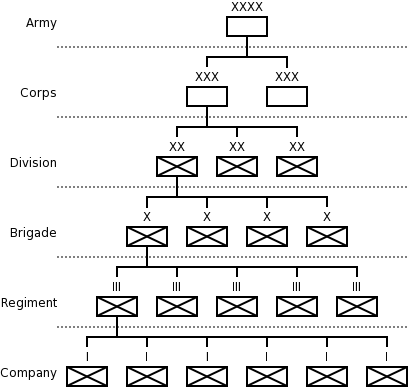The Hierarchy of Military Units: Terminological Note
Included in the organizational and battle descriptions that make up a large part of the story of this Whitney family in the Civil War are references to army units of varying size. Together such units form a command hierarchy, so that a serviceman who is a member of a unit lower in the hierarchy is considered a member of each of the units in a direct line up his hierarchical chain of command.
Most of the unit references in David Whitney's story—and those of his brother and brothers-in-law—are to only a few levels in the hierarchy, mostly low to mid-level units. For example, David served two separate enlistments, each in a distinct unit. From 1862 to 1863 he was in Company C of the 15th Vermont Regiment in the Second Vermont Briigade and then, from 1864 to 1865, in Company G of the 10th Vermont Regiment. References are usually to the regiment of service, even though the regiment is normally a part of a larger organization and contains smaller, subordinate units.
During its longer term of service—as strategic situations required higher-level commanders to regroup their forces—the 10th Regiment was assigned or temporarily detached to various higher levels. But both of the units David served in remained intact up to the regiment level, except for a few tactical skirmishes .
Since David and his kin served mostly in infantry units, most of the references here are to that kind. However, since artillery, cavalry, and other branches have somewhat varying unit designations, any references to those are slightly different. Nonetheless, the hierarchical principle remains.
In the infantry, the hierarchy from lowest to highest at the most common levels is team, squad, platoon, company, battalion (sometimes), regiment. In the artillery, units at the company level are called batteries and, in the cavalry, troops. Cavalry units at the battalion level are called squadrons.
At the next level, infantry regiments are grouped—often along with units from other branches of the army—into brigades, brigades into divisions, divisions into corps, and corps into armies. Occasionally a unit or part of a unit will be detached from its position in the hierarchy and assigned to a 'detail' or special temporary duty, either on its own or as part of another hierarchy.
Immediately below is a schematic representation of the typical hierarchy of army units in the Civil War. As presented here, the units up through division are marked as infantry units with crossed bars representing the crossed rifles of the infantry insignia but without specific branch markings for the more comprehensive units beyond that level.

Schematic image by Peter Eichman
Typical Unit Hierarchy during the Civil War
Each higher level unit usually has command over more than one unit of the type subordinate to it at the next level: for example, an infantry regiment might include six to eight subordinate companies.
In the diagram above, only the units at the very left side are shown linked to their subordinate units. In an array representing a real formation of units each unit symbolized at the various levels would be shown linked to its own subordinate units at lower levels.
At times the exact organization at the higher levels may change, but the relative position in the hierarchy remains the same for the designated unit. Each level of units has a characteristic number or letter to distinguish it from other units at the same level in the same command. In addition, units may also have distinctive names, such as the '15th Vermont Volunteers'.
Each unit at each level has one person in charge. 'Leader' is the designation for an officer or non-commissioned officer commanding the lower level units subordinate to a company up through platoon (not shown here). From company level on up, the commanding officer is designated as the 'commander'. Each leader or commander holds an army rank appropriate to his level of command. For instance, a squad is led by a sergeant, a company is usually commanded by a captain, and a regiment by a colonel.
In today's U.S. Army, the number of 'X's' above the unit symbols in the hierarchy schematic from brigade on up correlates to the number of stars that the commanding general of each respective unit wears. During the Civil War, Union Army officers generally wore one less star than their modern counterparts. Their Confederate counterparts, however, generally wore the number of stars closer to the modern correlations.
Commanders at each level have command over all units lower in their hierarchical chain. As the unit commands get larger, commanding officers acquire deputies and other officers and non-commissioned officers as part of their unit's administrative staff.
David Whitney remained an infantry private throughout his total service, but his brother and one brother-in-law gained commissions as officers and commanded combat infantry units. That brother-in-law also served subsequently as a staff officer of a higher level unit.
©2007 by Thomas Lee Eichman. All rights reserved.